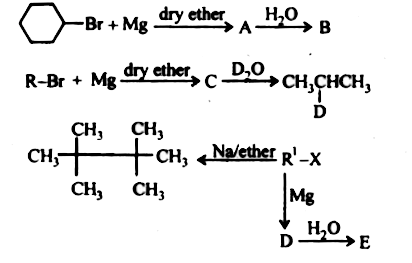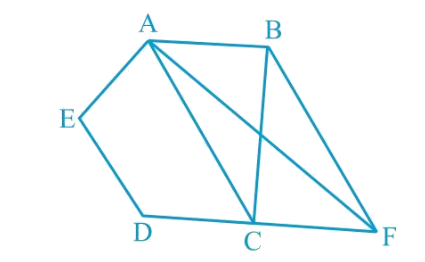Identity A, B, C, D, E, R and R' in the following:


R−Br+MgDry ether−−−−−→RMgBr(C)D2O−−→CH3C∣DHCH3
Since D geta attached to mame C-atom on which MgBr or Br was present so that
R−Br:CH3Br∣CHCH3 or R:CH3−H∣CH−CH3 and C:CH3−C∣CH3H−MgBr
Tert-alkyl halidea donot undergo Wurtz reaction. Therefore, the question is not correct. They undergo dehydrohalogenation to give alienes. Hence, R.=(CH3)3CH
CH3−CH3∣C=CH3Na,ether←−−−−−−HBrCH3−CH3∣C∣CH3−Brtert-butylbromide(R.Br)Mg−−→CH3−CH3∣C∣CH3−MgBr(D)H2O−−→CH3−CH3∣C∣CH3−H2-Methylpropane
Topper's Solved these Questions
- BOOK - MODERN PUBLICATIONCHAPTER - HALOALKANES AND HALOARENESEXERCISE - NCERT Textbooks Exercises1videos
HALOALKANES AND HALOARENES
- BOOK - MODERN PUBLICATIONCHAPTER - HALOALKANES AND HALOARENESEXERCISE - NCERT Textbooks Exercise21videos
HALOALKANES AND HALOARENES
- BOOK - MODERN PUBLICATIONCHAPTER - HALOALKANES AND HALOARENESEXERCISE - CONCEPTUAL QUESTIONS25videos
HALOALKANES AND HALOARENES
- BOOK - MODERN PUBLICATIONCHAPTER - GENERAL PRINCIPLES AND PROCESSES OF ISOLATION OF ELEMENTSEXERCISE - COMPETION FILE (Integer Type Numerical Value Type Questions)5videos
GENERAL PRINCIPLES AND PROCESSES OF ISOLATION OF ELEMENTS
- BOOK - MODERN PUBLICATIONCHAPTER - ORGANIC COMPOUNDS CONTAINING NITROGEN EXERCISE - UNIT PRACTICE TEST5videos
ORGANIC COMPOUNDS CONTAINING NITROGEN
Similar Questions

Identify A, B, C, D, E, R and R' in the following:View SolutionIdentify A, B, C, D, E, R and R1 in the following:
 View Solution
View SolutionIn A ABC, P and Q are respectively the mid-points of AB and BC and R is the mid-point of AP. Prove that: ar (RQC)=38 ar ( ABC)
View SolutionIn A ABC , P and Q are respectively the mid-points of AB and BC and R is the mid-point of AP. Prove that: ar(PRQ)=12ar(ARC)
View SolutionIn a ABC, D, E, F are the mi-points of sides BC, CA and AB respectively. If ar(ABC)=16cm2, then ar (trapezium FBCE)= 4 cm2 (b) 8 cm2 (c) 12cm2 (d) 10cm2
View SolutionP and Q are respectively the mid-points of sides AB and BC of a triangle ABC and Ris the mid-point of AP, show that (i) ar(PRQ)=12ar(ARC)(ii) ar(RQC)=38ar(ABC)(iii) ar(PBQ)=ar(ARC)
View SolutionIn Figure, ABCDE is a pentagon. A line through B parallel to AC meets DC produced at F. Show that: ar (ACB)=ar (ACF) ar (AEDF)=ar (ABCDE)
 View Solution
View SolutionIn Figure, ABCDE is a pentagon. A line through B parallel to AC meets DC produced at F. Show that ar(ACB)=ar(ACF) (ii) ar(AEDF)=ar(ABCDE)
View SolutionLet R be a relation in N defined by R={(a,b);a,b∈N and a=b2.} Are the following true: (i) (a,a)∈R ∀ a∈N (ii) (a,b)∈R⇒(b,a)∈R (iii) (a,b)∈R,(b,c)∈R⇒(a,c)∈R
View SolutionABCD is a parallelogram, G is the point on AB such that AG=2GB,E is a point of DC such that CE=2DE and F is the point of BC such that BF=2FC. Prove that : ar(ADEG)=ar(GBCE) ar(EGB)=16ar(ABCD)
View Solution

